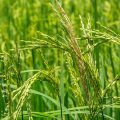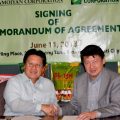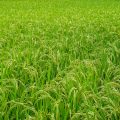The Philippines is shipping out hybrid rice seeds to Papua New Guinea (PNG) in a pioneering work to plant rice initially on 30 hectares.
The export opens up huge opportunities for the country as PNG virtually has no rice technology to speak of.
Shipment of the seeds to Gabadi, PNG is expected in the next two weeks after quarantine preparations will have been completed. Gabadi, a highly potential rice area, is near and north-west of PNG’s capital, Port Moresby.
“We will be shipping this week or next week hybrid rice varieties SL-8, SL-18, and SL 12 which is really for the wet season,” said SL AGritech Corp. (SLAC) Rice Consultant Frisco M. Malabanan.
“This is a great opportunity for us to use Philippine technology to help Papua New Guinea,” according to SLAC Chairman Henry Lim Bon Liong.
A vast area of 300,000 hectares offer opportunities for Philippines not only to plant rice in PNG for Guineans but also possibly for Filipinos.
The Department of Agriculture had looked a few years ago at PNG as a potential rice area from which to fulfill its rice self sufficiency goals, Malabanan said.
“PNG may become our own source of rice because it has a huge area for planting rice. They thought before they could not plant rice in their land. But a Filipino has demonstrated planting rice is possible,” he said.
The country’s export will be in partnership with a private company. It is backed up by the effort of a former minister of agriculture of PNG, Roy Ebarra.
This is likewise with the support of Philippine Ambassador to PNG Bienvenido V. Tejano who earlier tried planting rice in PNG and proved a good performance of rice planting there.
Despite rich natural resources—land and water— with which to plant rice, PNG has maintained its dependence on rice importation from Australia for many years. It has been importing around 300,000 metric tons of rice yearly.
“There’s no agricultural production yet (in Gabadi). But there’s a lot of water— rivers, and ground water is available just four to five meters below the ground,” said Malabanan.
There is also a potentially attractive margin for planting hybrid rice in PNG. The absence of rice supply makes price attractive at the equivalent peso level of P100 per kilo.
As there are no irrigation facilities, SLAC will demonstrate effectiveness of a dry direct seeding technique in planting rice.
Dry seeding means farm technicians will not sow pre-germinated seeds which is a usual practice in rice planting.
Overhead sprinklers will be used to irrigate the farm. Australians, according to Malabanan, have been known to get a good yield out of dry direct seeding from rice. This technique may give more than 10 metric tons per hectare of rice yield.
SLAC will send a technical staff and a farmer-technician to PNG for the training of New Guinean farmers.
Malabanan said the Philippines has been able to tap the PNG hybrid rice seed market through linkage with former Isabela Governor Edwin Uy and a philanthropic Australian citizen.
Uy has supported government’s rice self sufficiency program through hybrid rice over the last decade.
New Guineans have been traditionally eating boiled banana, boiled yam and other rootcrops. However, those who are able to taste rice desire to shift to eating rice over boiled root crops.
The large identified rice area in PNG may turn out to be a possible source of rice for Philippines as PNG just has a documented population of seven million people.
###
For any questions, please contact Ms. Analiza C. Mendoza, 0921-338-3816, 0916-266-6604.





